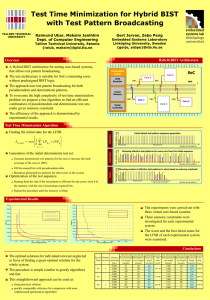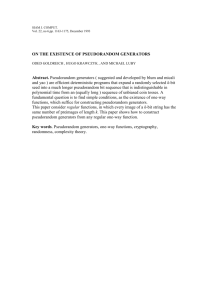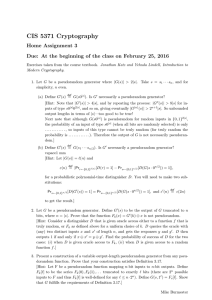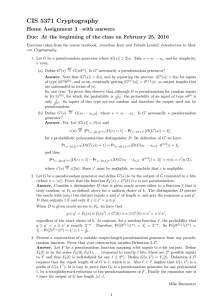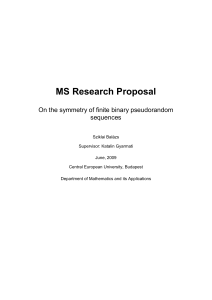Hybrid BIST Test Scheduling Based on Defect Probabilities
advertisement
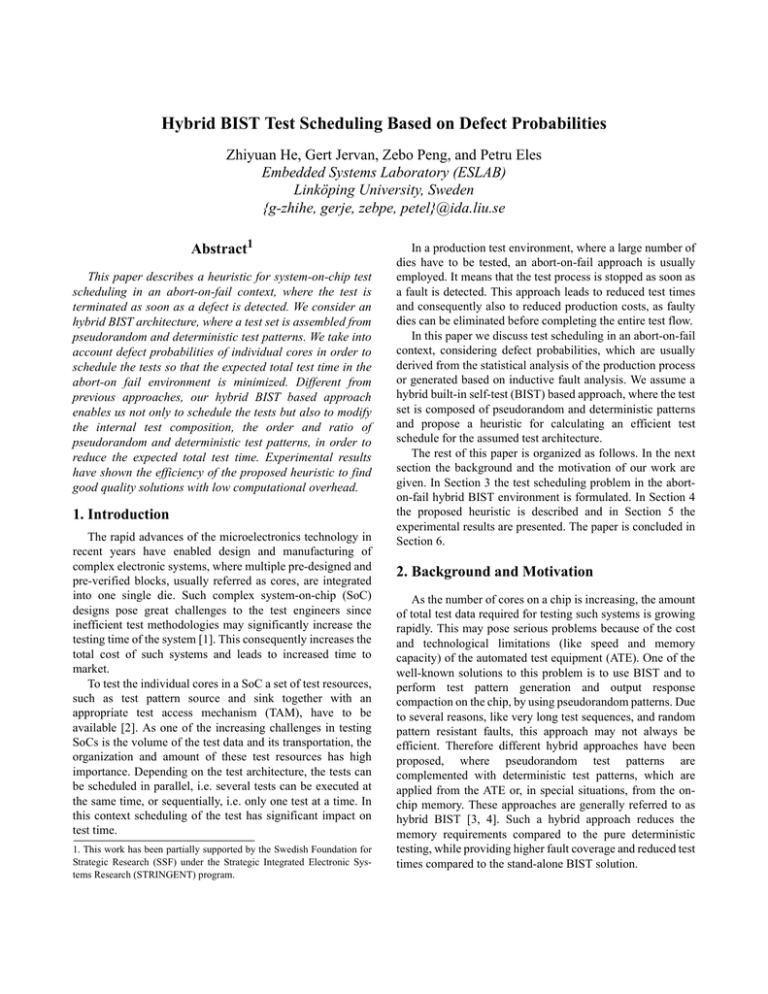
Hybrid BIST Test Scheduling Based on Defect Probabilities
Zhiyuan He, Gert Jervan, Zebo Peng, and Petru Eles
Embedded Systems Laboratory (ESLAB)
Linköping University, Sweden
{g-zhihe, gerje, zebpe, petel}@ida.liu.se
Abstract1
This paper describes a heuristic for system-on-chip test
scheduling in an abort-on-fail context, where the test is
terminated as soon as a defect is detected. We consider an
hybrid BIST architecture, where a test set is assembled from
pseudorandom and deterministic test patterns. We take into
account defect probabilities of individual cores in order to
schedule the tests so that the expected total test time in the
abort-on fail environment is minimized. Different from
previous approaches, our hybrid BIST based approach
enables us not only to schedule the tests but also to modify
the internal test composition, the order and ratio of
pseudorandom and deterministic test patterns, in order to
reduce the expected total test time. Experimental results
have shown the efficiency of the proposed heuristic to find
good quality solutions with low computational overhead.
1. Introduction
The rapid advances of the microelectronics technology in
recent years have enabled design and manufacturing of
complex electronic systems, where multiple pre-designed and
pre-verified blocks, usually referred as cores, are integrated
into one single die. Such complex system-on-chip (SoC)
designs pose great challenges to the test engineers since
inefficient test methodologies may significantly increase the
testing time of the system [1]. This consequently increases the
total cost of such systems and leads to increased time to
market.
To test the individual cores in a SoC a set of test resources,
such as test pattern source and sink together with an
appropriate test access mechanism (TAM), have to be
available [2]. As one of the increasing challenges in testing
SoCs is the volume of the test data and its transportation, the
organization and amount of these test resources has high
importance. Depending on the test architecture, the tests can
be scheduled in parallel, i.e. several tests can be executed at
the same time, or sequentially, i.e. only one test at a time. In
this context scheduling of the test has significant impact on
test time.
1. This work has been partially supported by the Swedish Foundation for
Strategic Research (SSF) under the Strategic Integrated Electronic Systems Research (STRINGENT) program.
In a production test environment, where a large number of
dies have to be tested, an abort-on-fail approach is usually
employed. It means that the test process is stopped as soon as
a fault is detected. This approach leads to reduced test times
and consequently also to reduced production costs, as faulty
dies can be eliminated before completing the entire test flow.
In this paper we discuss test scheduling in an abort-on-fail
context, considering defect probabilities, which are usually
derived from the statistical analysis of the production process
or generated based on inductive fault analysis. We assume a
hybrid built-in self-test (BIST) based approach, where the test
set is composed of pseudorandom and deterministic patterns
and propose a heuristic for calculating an efficient test
schedule for the assumed test architecture.
The rest of this paper is organized as follows. In the next
section the background and the motivation of our work are
given. In Section 3 the test scheduling problem in the aborton-fail hybrid BIST environment is formulated. In Section 4
the proposed heuristic is described and in Section 5 the
experimental results are presented. The paper is concluded in
Section 6.
2. Background and Motivation
As the number of cores on a chip is increasing, the amount
of total test data required for testing such systems is growing
rapidly. This may pose serious problems because of the cost
and technological limitations (like speed and memory
capacity) of the automated test equipment (ATE). One of the
well-known solutions to this problem is to use BIST and to
perform test pattern generation and output response
compaction on the chip, by using pseudorandom patterns. Due
to several reasons, like very long test sequences, and random
pattern resistant faults, this approach may not always be
efficient. Therefore different hybrid approaches have been
proposed, where pseudorandom test patterns are
complemented with deterministic test patterns, which are
applied from the ATE or, in special situations, from the onchip memory. These approaches are generally referred to as
hybrid BIST [3, 4]. Such a hybrid approach reduces the
memory requirements compared to the pure deterministic
testing, while providing higher fault coverage and reduced test
times compared to the stand-alone BIST solution.
2.1. Hybrid BIST Architecture
In this paper we assume the following test architecture:
Every core has its own dedicated BIST logic that is capable to
produce a set of independent pseudorandom test patterns, i.e.
the pseudorandom tests for all cores can be carried out
simultaneously. The deterministic tests, on the other hand, are
carried out for one core at a time, which means that only one
test access bus at the system level is needed. An example of a
multi-core system, with such a test architecture is given in
Figure 1. By using a hybrid BIST optimization methodology,
the optimal combination between pseudorandom and
deterministic test patterns for every individual core, for any
arbitrary memory constraint, can be found [4].
Embedded
Tester
Core 1
BIST
Test Access
Mechanism
Core 2
BIST
Controller
Memory
BIST
Core 3
BIST
Core 4
BIST
Core 5
SoC
Figure 1. A hybrid BIST based SoC test architecture
By using a straightforward bus scheduling approach, a test
schedule, illustrated in Figure 2, can be obtained.
individual core, so that the total test time of the entire system
can be minimized. During the scheduling process we will take
into account the defect probabilities of individual cores and
the impact of this information to the expected total test time
(ETTT). We have assumed here a test-per-clock approach,
although the methodology can easily be extended also for testper-scan architectures.
3. Definitions and Problem Formulation
Suppose that a system S, consisting of cores C1, C2, ... , Cn,
has a test architecture as depicted in Figure 1. Let us denote
with DTij and PRij, respectively, the j-th deterministic pattern
and j-th pseudorandom pattern in the respective sequences for
core Ci. PS0i and PSi0 denote the pseudorandom subsequences
generated, respectively, before and after the deterministic
sequence for core Ci. di and ri are the total number of
deterministic and pseudorandom test patterns for core Ci and
r0i and ri0 are the numbers of pseudorandom test patterns in
the subsequence PS0i and PSi0, respectively.
In this paper we consider that from the test scheduling
point of view the deterministic test sequence is an undividable
block, i.e. the deterministic test sequence cannot be divided
into smaller subsequences. The pseudorandom test sequence,
on the other hand, can be stopped and restarted in order to
enable the application of the deterministic test sequence at a
certain scheduled time moment. This assumption is a
consequence of the assumed test architecture, where
pseudorandom patterns are generated locally by every core,
while deterministic test patterns are applied from one single
test source and applied to one core at a time. This leads us to
a problem where also the test scheduling becomes hybrid: the
pseudorandom test sequences can be scheduled concurrently,
while the deterministic test sequences can be scheduled
sequentially.
3.1. System Defect Probability
Figure 2. An example of a hybrid BIST schedule
2.2. Abort-on-Fail Test Scheduling
The SoC test scheduling problem has been studied recently
by many authors [5-8]. In most of these approaches the
assumption is made that all tests are applied to completion. In
a production environment, however, the test can be aborted as
soon as a fault has been detected. Therefore the likelihood of
a block to fail during the test should be considered during test
scheduling in order to improve its efficiency [9-13].
In this paper an abort-on-fail test scheduling approach in a
hybrid BIST environment is proposed. A hybrid BIST
approach gives us an opportunity not only to schedule the tests
as fixed sequences of patterns, as it has been done in previous
approaches, but also to select the best internal structure for
individual test sets. This means, choosing the best order of
pseudorandom and deterministic test patterns for every
The system defect probability DF(S) is defined as the
probability of a system to be detected faulty during the
production test. Similarly, the core defect probability DF(Ci)
is defined as the probability of a core to be detected faulty
during the production test. Given the core defect probabilities,
the system defect probability can be calculated as follows:
n
DF ( S ) = 1 –
∏ (1 – DF(Ci)) .
(1)
i=1
In order to define the expected total test time, the
individual fault coverage of a test pattern, the passing
probability of a test pattern, and the accumulative passing
probability of a pseudorandom subsequence have to be
defined.
3.2. Individual Fault Coverage of a Test Pattern
To test a core Ci we have to apply di deterministic test
patterns and ri pseudorandom test patterns (in particular cases
one of these sets may be empty). By calculating the number of
faults F(DTij) or F(PRij) that are not yet detected2 by the
previous patterns before the j-th pattern and detected just by
the j-th pattern (either pseudorandom or deterministic), the
individual fault coverage of each test pattern can be calculated
as follows:
F ( DTij )
F ( PRij )
-, ( 1 ≤ j ≤ r i ) ,
FC ( DTij ) = -----------------, ( 1 ≤ j ≤ di ) , FC ( PRij ) = ----------------Fi
Fi
(2)
where FC(DTij) or FC(PRij) are respectively the individual
fault coverage of the j-th deterministic and j-th pseudorandom
pattern for core Ci. Fi is the total number of non-redundant
faults in core Ci.
3.3. Passing Probability of Test Patterns
The passing probability of a test pattern is defined as the
probability that the test pattern does not detect any fault. This
probability can be calculated from the defect probability of the
core and from the individual fault coverage of the test pattern:
P ( DTij ) = 1 – FC ( DTij ) × DF ( Ci ), ( 1 ≤ j ≤ di ) .
P ( PRij ) = 1 – FC ( PRij ) × DF ( Ci ), ( 1 ≤ j ≤ ri ) .
(3)
(4)
Here P(DTij) and P(PRij) are the passing probabilities of
the j-th deterministic and j-th pseudorandom pattern for the
core Ci, respectively. We have assumed here that the modelled
faults cover the defects in a uniform way, and we have 100%
defect coverage, in order to simplify the problem. These
assumptions do not have a large impact on the scheduling
results. In the following we say that a test has passed, when it
does not detect any fault and it has failed, when it detects at
least one fault.
3.4. Accumulative Passing Probability of Pseudorandom Subsequences
When considering an abort-on-fail approach, the test
should be terminated as soon as a fault is detected. This can
easily be achieved with deterministic test, where test
responses can be analyzed after every individual test pattern
and testing can be terminated at any time moment. In case of
pseudorandom test sequences the test responses are usually
compacted into a signature, and the test response can only be
analyzed at the end of the entire pseudorandom sequence.
Therefore test abortion in the case of pseudorandom patterns
can occur only either at the switching moment from the
pseudorandom test sequence to the deterministic test sequence
or at the end of the individual pseudorandom test sequence,
even if the fault occurs earlier.
In this paper we assume that pseudorandom sequences are
generated locally, in isolation, and therefore the
pseudorandom test of a core Ci can be executed independently
from the rest of the system. We assume that the pseudorandom
test of a core Ci can be executed at any moment when the
deterministic test patterns are not applied to Ci. Therefore the
original pseudorandom test sequence PSi of core Ci may be
divided into two subsequences PS0i and PSi0, denoting the
2. This information can be obtained from fault simulation
pseudorandom test sequence applied before and after the
deterministic test sequence, correspondingly. Both having
their accumulative passing probability:
r0i
P ( PS0i ) =
r0i + ri0
∏ P(PRij) , P(PSi0) = ∏
j=1
P ( PRij ) .
(5)
j = r0i + 1
3.5. Expected Total Test Time
As illustrated in Figure 3 the entire test procedure can be
divided into two sessions. During the first session the
deterministic patterns are applied sequentially to all cores. At
the same time up to n-1 pseudorandom sequences are also
generated and applied to their respective cores. In this session
the test can be terminated as soon as a fault is detected by a
deterministic test pattern (DT) or at the end of any
pseudorandom sequence (PS), if a fault was detected by the
pseudorandom sequence. The second session contains only
concurrently generated pseudorandom test sequences and,
consequently, the test can be terminated only at the end of any
of those sequences. In a hybrid BIST environment the test
length for all cores is usually the same (see Figure 2). In this
example we have generalized the problem and consider also
the situation where different cores have different test lengths,
which is also assumed in our algorithm.
Session 1
Core 1 DT11 DT12 DT13 DT14
Session 2
Deterministic Test Patterns
PS10
Pseudorandom Test Sequence
Core 2
PS02
Core 3
DT21
PS03
Core 4
DT31
PS04
Core 5
PS05
0
1
2
DT41 DT42
DT51 DT52 DT53
3
PS20
4
5
6
PS40
PS50
7
8
9
10
11
12
13
t
Figure 3. Hybrid BIST sessions for a system with 5 cores
Since every deterministic test pattern as well as
pseudorandom test sequence has its own passing probability,
an accumulative probability of test termination for any time
moment together with an expected total test time of the entire
system can be calculated.
Let us assume that we have a hybrid test sequence which
terminates at time point ta and there are totally m possible test
termination points t1, t2, ... , tm. Based on the previously
presented formulas the probability of a test to fail, p(tk), can be
calculated for any possible test termination point tk (1≤k≤m).
Similarly the probability that the entire test sequence passes,
without detecting a fault, q(ta), can be calculated. The
expected total test time (ETTT) of a system S can be defined
as follows:
m
ETTT =
∑ p(tk)T(tk) + q(ta)T(ta) ,
k=1
(6)
where T(tk) and T(ta) denote the time from the beginning of
the test to the test termination moments, indicated by tk and ta,
respectively.
As outlined earlier in the section, the entire test process can
be divided into two test sessions, where the test termination
can take place either after every individual pattern (Session 1)
or after every pseudorandom sequence (Session 2). We have:
n
ETTT =
di
∑ ∑ p(DTij)T(DTij) + ∑ p(PSl)T(PSl) + q(ta)T(ta) ,
ETTT =
∑∑
i = 1j = 1
r
∑
l=1
⎞
⎛
⎞⎛
P ( y )⎟ T (DTij ) +
P ( x )⎟ ⎜ 1 –
⎜
⎠
⎝ ∀x ∈ S (DT )
⎠ ⎝ ∀y ∈ S (DT )
∏
p
∏
ij
f
ij
⎞
⎛
⎞⎛
⎛
⎞
P ( y )⎟ T ( PSl ) + ⎜
P ( x )⎟ ⎜ 1 –
P ( x )⎟ T (ta )
⎜
⎠
⎝ ∀x ∈ S (PS )
⎠ ⎝ ∀y ∈ S (PS )
⎝ ∀x ∈ S (t )
⎠
∏
p
Pseudorandom Test Sequence
Core 1 DT11 DT12 DT13 DT14
Elements in Sp(PS10)
Elements in Sf(PS10)
Core 2
PS02
DT21
PS20
PS03
DT31
Core 3
(7)
PS04
Core 4
DT41 DT42
l=1
where DTij denotes the j-th deterministic test pattern of a core
Ci, and PSl denotes the l-th pseudorandom test sequence in
session two. T(DTij) denotes the time from the beginning of
the test up to and including pattern DTij and p(DTij) is a
probability that faults are detected by the pattern DTij.
Similarly p(PSl) is the probability that faults are detected by
the sequence PSl and T(PSl) is the time from the beginning of
the test up to and including sequence PSl. q(ta) and T(ta) have
the same meaning as in Equation (6).
At any test termination point the test sequences can be
divided into 2 sets. Set Sp contains all the sequences
(pseudorandom and deterministic) that have been applied and
passed without detecting a fault, while set Sf contains
deterministic patterns and pseudorandom sequences that
detected the fault concurrently. By adding all the products of
the test time and fault detection probabilities at every possible
termination point, we have finally:
di
Deterministic Test Pattern
PS10
r
i = 1j = 1
n
T(PS10)
∏
l
f
.
(8)
∏
l
p
a
In Figure 4 we have illustrated graphically the situation,
when a test is aborted before completion. In this example we
have assumed, that the fault has been detected by the
pseudorandom sequence PS10 and the test response has been
analyzed at the end of the sequence at time moment t=6. At the
same time moment also the deterministic test pattern DT52
was applied and the pseudorandom sequence PS03 finished.
Both of them, DT52 and PS03, may have detected a fault as
well. In this situation Sp(PS10) = {DT11, DT12, DT13, DT14,
PS05, DT51} contains all tests that have been successfully
passed and Sf(PS10) = {PS10, PS03, DT52} contains all tests
that potentially detected a fault. Note that PS02 and PS04
cannot be included to neither Sp(PS10) nor Sf(PS10) since the
results of these pseudorandom test sequences can be analyzed
only at the end of the sequence. Thus the probability that the
test is terminated at t=6 is:
⎞
⎛
⎞⎛
P ( x )⎟ ⎜ 1 –
P ( y )⎟
⎜
⎠
⎝ ∀x ∈ S (PS )
⎠ ⎝ ∀y ∈ S (PS )
∏
p
∏
10
f
.
10
Equation (8) is essentially the sum of terms, each
corresponding to a possible termination time. Each term
equals the test length multiplied by the probability that the
test is terminated at that point.
PS40
DT52
PS05
Core 5
0
1
2
DT51
3
4
DT53
5
6
PS50
7
8
9
10
11
12
13
t
Figure 4. Example of the test termination in session 1
3.6. Problem Formulation
Let us assume a core-based system with the given test
architecture as described in section 2.1. For such a system an
optimal hybrid test set and a straightforward schedule can be
calculated [4]. The objective of this paper is to take into
account defect probabilities of individual cores and to use this
information to schedule the tests in such a manner that the
expected total test time (ETTT) is minimized.
4. Proposed Heuristic for Test Scheduling
Our objective is to develop an iterative heuristic for ETTT
minimization. As described earlier, the test scheduling
problem in the hybrid abort-on-fail test environment is
essentially scheduling of deterministic test sequences, such
that the ETTT of the system is minimal.
By changing the schedule of deterministic sequences, the
set of passed test sequences Sp and the set of failed test
sequences Sf, affiliated to every possible test termination
moment, is also changed. Consequently the individual fault
coverage of each test pattern must be recalculated, since the
passing probability of these patterns is changed. This will lead
to the recalculation of the ETTT as described in the previous
section.
It would be natural to order the tests in such a way, that the
cores with high failure probability would be tested first.
However such a naive schedule does not necessarily lead to
the minimal expected total test time. In addition to the defect
probabilities also the efficiency of test patterns and the length
of individual test sequences have to be taken into account. Due
to the complexity of the problem we propose here an iterative
heuristic that can be efficiently used.
In our heuristic we assume that we start from a subset of m
already scheduled deterministic sequences, m<n. The
objective is to increase this subset to m+1 scheduled
deterministic sequences. This is obtained by selecting a
deterministic sequence from the remaining unscheduled n-m
candidate sequences and inserting it into the existing sequence
in such a way, that the resulting ETTT is as short as possible.
This procedure is repeated for all cores m = 0, 1, ... , n-1. For
the initial solution (m=0) the test sequence with the lowest
ETTT is chosen.
At every iteration, (n-m)(m+1) different solutions have to
be explored since there are n-m candidate sequences and m+1
insertion points for each candidate. The heuristic is illustrated
in Figure 5. Here we have illustrated a situation where two
deterministic test sequences out of five are already scheduled
(m=2, n=5). For every candidate schedule there are three
different insertion points, indicated by arrows. During each
iteration step the ETTT for all candidate sequences for all
possible insertion points is calculated and the candidate
sequence will be finally inserted to the point which produces
lowest ETTT.
Scheduled Deterministic Sequence
sched1
Pseudorandom Test Sequence
Core 1 DT11 DT12 DT13 DT14
Ins
PS10
Deterministic Sequence to be Scheduled
Ins
Ins
candidate3
PS02
Core 2
Ins
DT21
Ins
Core 3
candidate1
Ins
PS03
Ins
PS20
DT31
Ins
Core 4
Ins
candidate2
PS04
DT41 DT42
PS40
sched2
Core 5
PS05
0
1
2
DT51 DT52 DT53
3
4
5
6
PS50
7
8
9
10
11
12
13
t
The new situation is illustrated in Figure 6. In this example
the deterministic test sequence of core 4 was chosen and
inserted into the schedule after the core 1.
Scheduled Deterministic Sequence
sched1
PS10
Core 2
PS02
Pseudorandom Test Sequence
Deterministic Sequence to be Scheduled
candidate3
DT21
PS20
candidate1
PS03
Core 3
DT31
just scheduled
PS04
Core 4
DT41 DT42
PS40
sched2
PS05
Core 5
0
1
2
3
DT51 DT52 DT53
4
5
6
7
8
PS50
9
// Initialization
Scheduled[1..n] = { };
Candidate[1..n] = {1, 2, ... , n};
Min_Cost = a large value;
Candidate#_Chosen = 0;
InsertPosition#_Chosen = 0;
// Iteration
// Outer loop
for (Curr_Scheduled# = 1 to n) do {
Min_Cost = a large value;
m = Curr_Scheduled_Number(Scheduled[ ]);
// Middle loop
for (Curr_Candidate# = 1 to n-m) do
// Inner loop
for (Curr_InsertPosition# = 0 to m) do {
New_Cost = Cost(Curr_Candidate#, Curr_InsertPosition#);
if (New_Cost < Min_Cost) {
Min_Cost = Current_Cost;
Candidate#_Chosen = Curr_Candidate#;
InsertPosition#_Chosen = Curr_InsertPosition#;
}
}
Insert(Candidate#_Chosen, InsertPosition#_Chosen, Scheduled[ ]);
}
// Output
Output(Scheduled[1..n]);
Figure 7. Pseudo-code of the algorithm
Figure 5. Initial solution for the iteration
Core 1 DT11 DT12 DT13 DT14
loop iteratively increases the number of already scheduled
sequences. The middle loop iteratively goes through all
candidate sequences in the current candidate set and the inner
loop calculates for the chosen candidate sequence a new
ETTT in every possible insertion point. The solution with
lowest ETTT is chosen and the new schedule forms an initial
solution for the next iteration. The heuristic stops when all
tests have been scheduled.
10
11
12
13
t
Figure 6. The new locally optimal order after the iteration
In Figure 7 the pseudo-code of the algorithm is presented.
As described earlier, the test schedule is obtained
constructively by enlarging the subset of scheduled test
sequences. During each iteration we add one additional
sequence into the previously scheduled set of sequences and
explore the solution space in order to find the optimal
insertion point for the new sequence. The algorithm starts with
the initialization phase. Thereafter comes the iterative
scheduling heuristic, consisting of three main loops. The outer
The algorithm proposed here has a polynomial
computational complexity of O(kn4), where n is the number of
cores and k is the average number of deterministic test patterns
prepared for every core.
5. Experimental Results
We have performed experiments with 9 different designs,
consisting of 5 to 50 cores (Table 1). In order to obtain
diversification we have calculated for every experimental
design 5 different hybrid test sets (different ratio of
pseudorandom and deterministic test patterns) and the
experimental results illustrate the average of five experiments.
The defect probabilities for individual cores have been given
randomly, while keeping the system defect probability at the
value 0.6.
In order to illustrate the significance of test scheduling we
have performed another set of experiments for comparison,
where a random schedule is assumed. As it can be seen from
Table 1, by employing our heuristic the ETTT can be reduced
in a range of 5-15%, which is very relevant for large volume
production testing.
As our heuristic can produce only a near optimal solution,
experiments for estimating the accuracy of the solution were
performed. For this purpose a simulated annealing algorithm
and an exhaustive search has been used, where possible. As it
can be seen from Table 1 our heuristic is able to produce
results similar or very close to the results obtained with
simulated annealing and exhaustive search, while having
significantly lower computation times. These comparisons are
also illustrated in Figure 8 and Figure 9. In Figure 8 we have
compared the ETTT values, calculated with different
approaches, while in Figure 9 the CPU times with our
heuristic and with simulated annealing are compared.
6. Conclusions
In this paper a test scheduling methodology in the context
of a hybrid BIST environment was presented. Different from
other approaches the defect probabilities of individual cores
were taken into consideration and a methodology for expected
total test time calculation in the abort-on-fail environment was
proposed. We have also developed a scheduling heuristic for
expected total test time minimization, that produces nearoptimal solutions with low computational overhead.
Experimental results have shown the efficiency of the
proposed method.
References
[1] B. T. Murray, and J. P. Hayes, “Testing ICs: Getting to the core
of the problem”, IEEE Transactions on Computer, Vol. 29, No. 11,
1996, pp. 32-38.
[2] Y. Zorian, E. J. Marinissen, and S. Dey, “Testing Embedded
Core-Based System Chips”, IEEE International Test Conference
(ITC), 1998, pp. 130-143.
[3] G. Jervan, Z. Peng, and R. Ubar, “Test Cost Minimization for
Hybrid BIST”, IEEE International Symposium on Defect and Fault
Tolerance in VLSI Systems (DFT), 2000, pp. 283-291.
[4] G. Jervan, P. Eles, Z. Peng, R. Ubar, and M. Jenihhin, “Test
Time Minimization for Hybrid BIST of Core-Based Systems”,
IEEE Asian Test Symposium (ATS), 2003, pp. 318-323.
[5] E. Cota, L. Carro, M. Lubaszewski, and A. Orailoglu, “Test
Planning and Design Space Exploration in a Core-based
Environment”, Design, Automation and Test in Europe Conference
(DATE), 2002, pp. 478-485.
[6] Y. Huang, W.-T. Cheng, C.-C. Tsai, N. Mukherjee, O. Samman,
Y. Zaidan, and S. M. Reddy, “Resource Allocation and Test
Scheduling for Concurrent Test of Core-based SOC Design”, IEEE
Asian Test Symposium (ATS), 2001, pp. 265-270.
[7] V. Iyengar, K. Chakrabarty, and E. J. Marinissen, “Test
Wrapper and Test Access Mechanism Co-optimization for Systemon-Chip”, International Test Conference (ITC), 2001, pp. 10231032.
[8] E. Larsson, and Z. Peng, “An Integrated Framework for the
Design and Optimization of SOC Test Solutions”, Journal of
Electronic Testing; Theory and Applications (JETTA), Vol. 18, No.
4/5, 2002, pp. 385-400.
[9] S. D. Huss, and R. S. Gyurcsik, “Optimal Ordering of Analog
Integrated Circuit Tests to Minimize Test Time”, ACM/IEEE
Design Automation Conference (DAC), 1991, pp. 494-499.
[10] L. Milor, and A. L. Sangiovanni-Vincentelli, “Minimizing
Production Test Time to Detect Faults in Analog Circuits”, IEEE
Transactions on Computer-Aided Design of Integrated Circuits
and Systems, Vol. 13, No. 6, 1994, pp. 796-813.
[11] W. J. Jiang, and B. Vinnakota, “Defect-Oriented Test
Scheduling”, IEEE Transactions on Very Large Scale Integration
(VLSI) Systems, Vol. 9, No. 3, 2001, pp. 427-438.
[12] S. Koranne, “On Test Scheduling for Core-based SOCs”,
International Conference on VLSI Design (VLSID), 2002, pp. 505510.
[13] E. Larsson, J. Pouget, and Z. Peng, “Defect-Aware SOC Test
Scheduling”, IEEE VLSI Test Symposium (VTS), 2004, pp. 359364.
Table 1. Experimental Results
Number of Cores
5
7
10
12
15
17
20
30
50
ETTT
CPU
Time(s)
ETTT
CPU
Time(s)
ETTT
CPU
Time(s)
ETTT
CPU
Time(s)
ETTT
CPU
Time(s)
ETTT
CPU
Time(s)
ETTT
CPU
Time(s)
ETTT
CPU
Time(s)
ETTT
CPU
Time(s)
Random Scheduling
248.97
1.1
261.38
64.4
366.39
311.8
415.89
346.8
427.34
371.6
544.37
466.6
566.13
555.4
782.88
822.4
1369.54
1378.0
Our Heuristic
228.85
0.6
232.04
1.4
312.13
6.6
353.02
12.2
383.40
25.2
494.57
43.6
517.02
85.4
738.74
380.4
1326.40
3185.0
Simulated Annealing
228.70
1144.2
231.51
1278.5
311.68
3727.6
352.10
4266.8
381.46
5109.2
493.93
6323.8
516.89
7504.4
736.51
11642.4
1324.44
21308.8
Exhaustive Search
228.70
1.2
231.51
80.0
311.68
112592.6
N/A
N/A
N/A
N/A
N/A
N/A
N/A
N/A
N/A
N/A
N/A
N/A
1400
Random Scheduling
11642.4
12000
Our Heuristic
10000
Sim ulated Annealing
Our Heuristic
Simulated Annealing
1000
Exhaustive Search
CPU Time (s)
Expected Total Test Time
1200
800
600
4000
200
2000
0
0
7
10
12
15
17
Number of Cores
20
30
50
Figure 8. Comparison of expected total test times
6323.8
5109.2
6000
400
5
7504.4
8000
3727.6
4266.8
3185.0
1144.2 1278.5
0.6
1.4
5
7
6.6
12.2
10
12
25.2
43.6
15
17
Design Size
85.4
380.4
20
30
Figure 9. Comparison of CPU times
50
